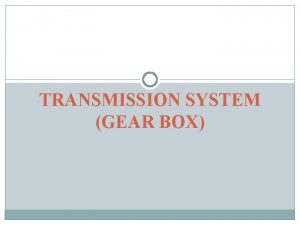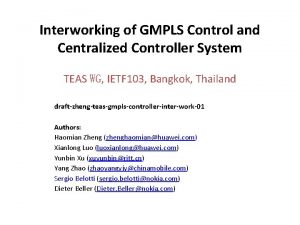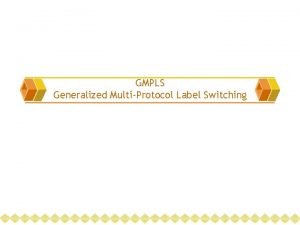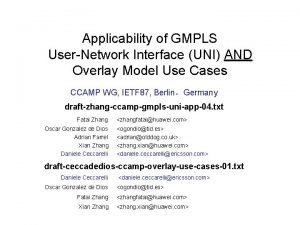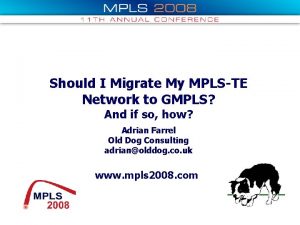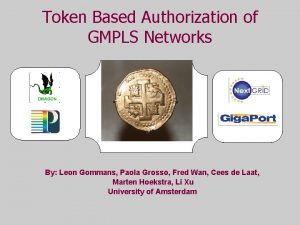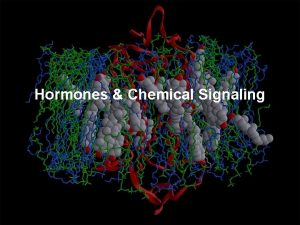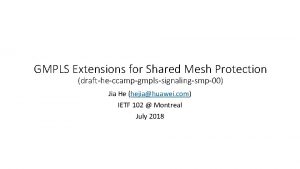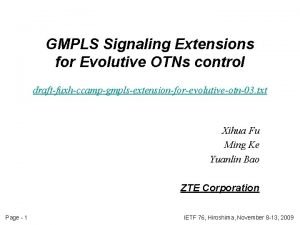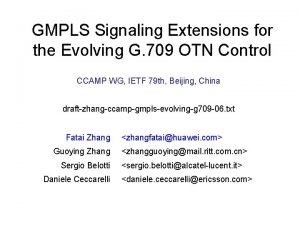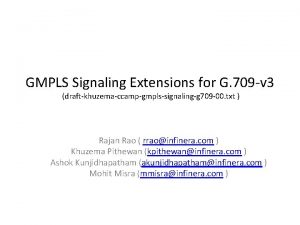GMPLS Signaling Extensions for Shared Mesh Protection draftietfteasgmplssignalingsmp01







- Slides: 7

GMPLS Signaling Extensions for Shared Mesh Protection (draft-ietf-teas-gmpls-signaling-smp-01) Jia He (hejia@huawei. com) Italo Busi (Italo. Busi@huawei. com) Jeong-dong Ryoo (ryoo@etri. re. kr) Bin Yeong Yoon (byyun@etri. re. kr) Peter Park (peter. park@kt. com) IETF 105 @ Montreal March 2019

History • Adopted as TEAS WG document on January 14, 2019 • Updated to address comments received during WG adoption: • Difference between SMP and SMR • APS configuration • Added description of notifications • Jeong-dong, Bin and Peter added as co-authors • Yuji added as contributor 2

Notification 1: Resource Unavailable 1) Working LSP 2 fails: • Node H generates APS(SF). • Node E sends Path. Err and Resv. Err with the error code/sub-code "Policy Control Failure/Hard Preempted" toward node A and node D, respectively, to notify that protecting LSP 1 is preempted • Path_State_Removed flag in the ERROR_SPEC object MUST not be set in Path. Err and Resv. Err messages to avoid protecting LSP 1 being torn down A B D C Path. Err Resv. Err E F Protecting LSP 1 Protecting LSP 2 G APS(SF) H J K Working LSP 1 Working LSP 2 M Preemption priority of protecting LSP 1 is lower than that of protecting LPS 2 3

Notification 2: Resource Available 2) Working LSP 2 is recovered: • Node H generates APS(NR). • Node E sends Resv and Path messages toward node A and node D, respectively, to notify that protecting LSP 1 is no longer preempted A B D C Resv Path E F G Working LSP 1 Working LSP 2 APS(NR) H J K M Protecting LSP 1 Protecting LSP 2 4

SMP Pre-emption priority • Section 12 of ITU-T G. 808. 3 defines pre-emption rules: • Higher SMP pre-emption priority • Higher SMP APS request priority • Protection LSP identifier • SMP pre-emption priority seems different than GMPLS setup priority and holding priority • Protection LSPs pre-empted by the SMP APS should/could be maintained in the control plane • A new object needs to be defined. Two options 1) Define a new Object 2) Define a new field within the PROTECTION Object 5

APS Configuration • APS Protocol is “for further study” in section 14 of ITU-T G. 808. 3 • Assumption: APS protocol and message format is technology and/or vendor specific • APS protocol messages need to identify the protection LSP an APS request applies to • Some implementations may re-use GMPLS LSP identifiers • Other implementations may define SMP APS identifiers which need to be configured when the protection LSP is setup • Possible options 1. Consider this outside the scope (as in current I-D) 2. Define a new Object whose content is vendor-specific 3. Define a new Object with a TLV structure • Some Types for standard-track allocation (standard technology-specific APS) • Some Types for expert review allocation (vendor-specific APS) 6

Next Steps • Resolve pending open issues • Get further feedbacks/comments from the WG 7
